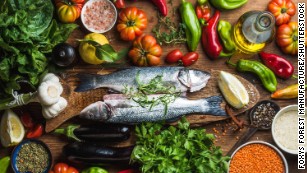Foods to boost your mood, now that you really need it.

3 easy recipes with ingredients you already have at home 02:49
(CNN)It’s all too easy to reach for comfort foods when feeling stressed or anxious.
Consuming that extra scoop of ice cream or another handful of chips or cookies, however, can cause feelings of guilt — and even more stress — along with fatigue and irritability from sugar highs and lows.
Yet the opposite is also true: Consuming healthy mood-boosting foods can deliver important brain nutrients while positively impacting your well-being.
Below are some nutritious and delicious foods that can improve your frame of mind while helping you avoid the #quarantine15 and other related health issues.
Healthy, mood-boosting comfort foods
We know that omega-3 fatty acids found in fish — particularly docosahexaenoic acid (DHA) — play an important role in brain development. But these fats may also play a role in our mental health, too. In one meta-analysis involving 26 studies and over 150,000 participants, researchers found that consuming high amounts of fatty fish may help protect us from depression.
Another study examining the mechanisms by which omega-3s work concluded that while many factors may contribute to a rise in depression, “dietary recommendations suggesting proper intake of omega-3 polyunsaturated fatty acids … can result in substantial benefits for the general population.”
“Those who consume ample amounts of the omega-3 fat DHA are less prone to depression, aggressiveness and hostility,” according to registered dietitian Elizabeth Somer, author of “Food and Mood” and medical advisory board member for Persona Nutrition.
The healthy fat “helps form healthy membranes that easily transport nutrients into brain cells, lowers inflammation and raises serotonin levels,” Somer added. Serotonin is one of the key neurotransmitters influencing our mood, so incorporating plenty of DHA in your diet can help you maintain a balanced outlook.
Somer recommends aiming for at least two servings of fatty fish per week, such as salmon, herring, mackerel or sardines, or looking for foods fortified with the omega-3 DHA. For a tasty way to enjoy omega-3 fats, check out my simple salmon recipe below.
Green veggies: spinach, broccoli, Brussels sprouts
These green veggies are a source of folate, a B vitamin that’s essential for the body’s production of serotonin, according to Somer.
In one meta-analysis, researchers found that individuals with depression consume less folate and have lower blood levels of the vitamin compared to those without depression.
In addition to increasing the risk for depression, poor intake of folate is also linked to fatigue and poor memory.
Somer recommends consuming at least 400 micrograms of folate per day, an amount found in 1 ½ cups of sautéed spinach. Beans, peas, lentils, avocado and strawberries are other good sources of folate.
Probiotics: yogurt, kefir, sauerkraut, kimchi
You may have heard a lot about probiotics and their role in keeping our digestive tract healthy, but recent research suggests that probiotics may also play a role in keeping up our spirits. One study found that probiotics may help reduce negative thoughts associated with sad moods, and it suggested that probiotics supplementation warrants further research as a potential preventive strategy for depression.
Probiotics can help alleviate depressive symptoms, according to another recent review involving 10 studies. There is a need, however, for more research to determine the ideal duration of treatment, dosage and strain of probiotics to achieve better mental health.
One of the easiest ways to enjoy a daily dose of probotics is to consume a cup of low-fat yogurt with fresh fruit or a smoothie with yogurt as a snack.
Whole grains: oats, brown rice, whole wheat bread
Whole grains are rich in B vitamins that are important for energy and optimal brain health. Thanks to their fiber content, whole grains also help to keep blood sugar from spiking and crashing, which can help you avoid mood swings.
“If you’re eating bread, reach for the whole wheat over the white, since it also stabilizes blood sugar levels,” Somer said. “Refined grains found in white bread can send you on a blood sugar roller coaster, leaving you jittery, grumpy and hungry.”
Carbohydrates including whole grains also boost levels of serotonin, the “feel-good brain chemical,” according to Somer. Adding some protein, like chicken, legumes, fish or nut butter with whole grains can help, too, as protein triggers the release of norepinephrine, a brain chemical that provides an energy and mood lift.
A whole grain bagel with peanut butter, for example, can make for a nutritious mini-meal. Somer also likes whole grain crackers or bread sticks with low-fat cheese.
Vitamin D: Egg yolks, fatty fish; fortified milks
We’ve talked about vitamin D and its relation to bone health and immunity, but research has also revealed a connection between vitamin D and mental health. In one recent meta-analysis involving over 30,000 people, those with low vitamin D levels were more likely to be depressed.
Vitamin D deficiency has also been associated with low moods and poor cognitive performance in older adults.
Our bodies synthesize vitamin D from the sun’s ultraviolet light, so most of us can meet at least some of our D needs during sunnier months. Certain factors including darker skin and air pollution, however, can reduce the ability of the sun to produce vitamin D in human skin, according to Dr. Michael Holick, an expert on Vitamin D research from Boston University.
So in the wintertime, it’s especially important to seek out vitamin D-rich foods, like fatty fish, eggs and fortified foods and beverages, or vitamin D supplements.
Yes, dark chocolate (in moderation)
This sweet treat can definitely give us a mood boost. Chocolate contains caffeine and theobromine, a compound that may affect mood. The popular indulgence may also boost serotonin levels.
What’s more, dark chocolate also contains healthful flavanols that have been shown to help lower blood pressure and cholesterol, and improve cognition.
To keep weight in check, limit portions to 1 ounce of dark chocolate daily, or about 150 calories.
Coffee and tea
Coffee and tea are sources of caffeine, which can give us a lift.
“When we consume caffeine, it has positive effects on mood and alertness, and people like these beneficial effects,” said Mary M. Sweeney, an instructor who researches caffeine’s effects on individuals in the department of psychiatry and behavioral sciences at the Johns Hopkins University School of Medicine.
One meta-analysis revealed that consuming coffee (and tea) may help protect against depression.
Get CNN Health’s weekly newsletter
Sign up here to get The Results Are In with Dr. Sanjay Gupta every Tuesday from the CNN Health team.
Just keep in mind that people vary in their tolerance to caffeine. “Many people consume caffeine without negative consequences, but for some individuals, either regularly consuming too much caffeine or consuming too much at once can cause distress,” Sweeney said.
Green tea has less caffeine than coffee, is a rich source of the antioxidant epigallocatechin gallate, or EGCG, and also contains the amino acid theanine, which may help reduce stress and promote calm feelings.
For a healthy boost, check out my matcha (green tea) latte below.
Mood-boosting recipes
Mustard-crusted salmon with roasted green beans and shallots (from my book, “The Beauty Diet“)
Total time: 45 minutes
Nonstick cooking spray
1 pound green beans, trimmed
2 shallots, sliced
2 teaspoons extra virgin olive oil
1⁄2 teaspoon kosher salt
1⁄2 teaspoon freshly ground black pepper
4 6-ounce wild salmon fillets
2 tablespoons Dijon mustard
2 teaspoons honey
Preheat the oven to 425°F. Line a baking sheet with foil and spray with nonstick cooking spray; set aside. Bring a large pot of water to a boil, add the green beans, and boil for 3–5 minutes or until bright green and slightly tender. Drain and run under cold water until cool.
Drain well; toss with the shallots, oil, salt, and 1⁄4 teaspoon of the pepper; and place on one half of the baking sheet. Place the salmon fillets, skin side down, on the other half of the baking sheet. In a small bowl, mix the mustard and honey and spread evenly on the salmon fillets.
Season with the remaining 1⁄4 teaspoon pepper and roast in the oven until the salmon is just cooked through and the beans are lightly browned, 12–14 minutes.
Yield: 4 servings (6 ounces salmon and 4 ounces green beans each)
Immunity boosting matcha latte (from www.lisadrayer.com)
Total time: 10 minutes
2 cups 1% milk fat vitamin D-fortified milk
1 1⁄2 teaspoons matcha powder
1 tablespoon hot water (boiling is ideal)
1 1⁄2 tablespoons maple syrup
In a blender, blend milk for about 30 seconds, until frothy. In a small bowl, dissolve matcha powder in hot water. Add milk, dissolved matcha, and maple syrup to a small pot and heat over medium heat for about 5 minutes, until hot but NOT boiling. The mixture should be very frothy but if it reaches boiling, the froth will start to disappear. Serve warm.
Yields: 2 servings
Correction: A previous version of this story incorrectly described the milk blending time period in the matcha latte recipe.




No responses yet